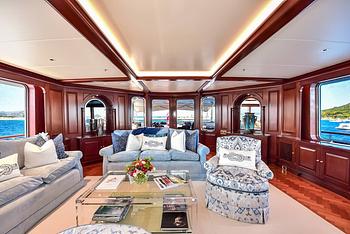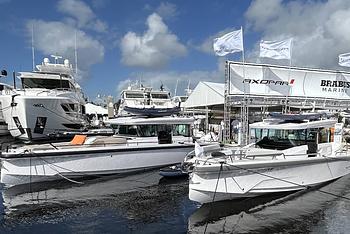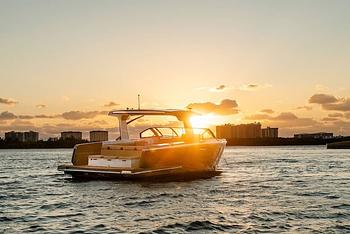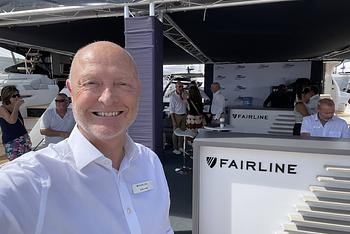Growing up in Summerville, S.C., not far from the Scout Boats factory, Alan Lang landed a summer job at Scout and never left once he finished college. The director of sales & marketing has now watched the center console market evolve since the late ‘90s and offers his perspective in conversation with Rightboat content director, John Burnham.
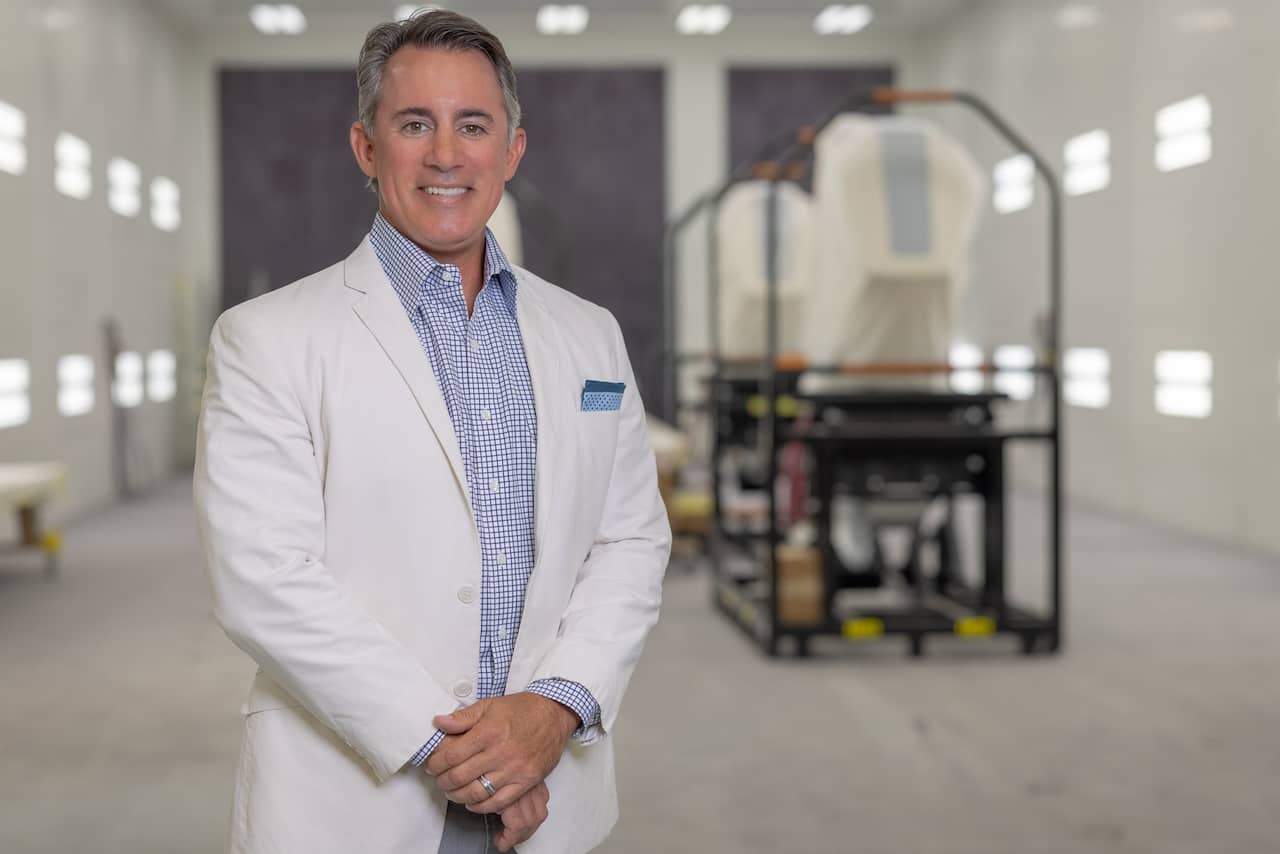
Alan Lang, Scout Boats sales & marketing director.
John Burnham: Steve Potts founded Scout Boats in 1989. What brought to Scout you not long after that and kept you there ever since?
Alan Lang: I grew up loving the water, going out on the boat with my family, fishing, skiing, surfing, etc. When I was in high school, I met Stevie Potts Jr. (now VP of Research & Development) and asked if he could help me get a job for the summer, and I never left, so I’ve been here 26 years. My favorite part of my job is the people I’ve met and become great friends with, from my colleagues to our dealers and customers. Our business revolves around family fun and lifestyle, and I can’t think of many things cooler to sell.
Burnham: There are so many center consoles out there…how do you explain the center console market to a newer boater?
Lang: I like to get a feel from customers on how they’re going to use the boat first. What I find myself often pointing out about Scout is the fact that it’s not just a fishing boat, it’s a boat that you can have a date night on, entertain clients, take friends or family out. It’s the Ladies and Gentlemen’s fishing boat that checks all the boxes with both performance and class. There aren’t many other center consoles that can truly do that.
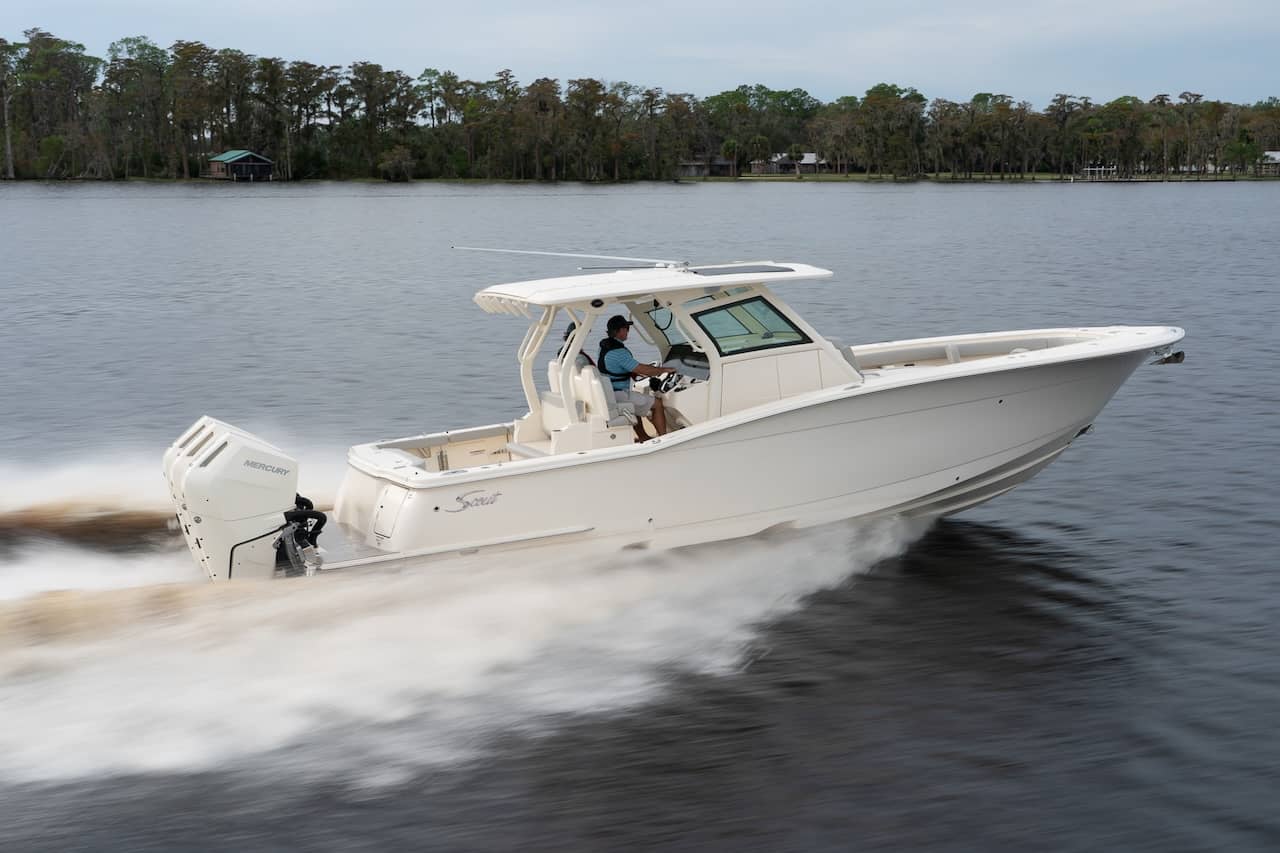
The Scout 355 LXF can be equipped with a Seakeeper 3DC gyro stabilizer.
Burnham: What other center console categories or distinctions do you look at?
Lang: One of the other key distinctions is customization. We’re family owned and able to build semi-custom—we can move quickly. There's not a whole lot of bureaucracy or red tape involved; we're building a custom 42 right now that has a list probably 30 items long of custom features. These are things we can do that other boat companies might not be willing or able to do.
Burnham: So that’s one of your unique selling propositions, because you're not a corporate operation?
Lang: Just working tight knit and being willing to be very involved with our customers. My cell phone is on the website. I scour our competitors’ websites and don't see their director of sales and marketing's cell phone on any. I’m known for pretty much answering my phone 24/7. I like to work directly with these customers in feeling out there needs in emails and phone conversations and text to help us get through some of the custom builds, whereas with a lot of other manufacturers you have to go through a dealer, and then some stuff gets lost in translation. Everybody here is a team player, and everybody works hard.

The Scout 425LXF utilizes carbon/glass construction with epoxy resins.
Burnham: If you look at older center consoles, regardless of brand, what distinguishes a center console built early in your career with one in the middle of it, or more recent?
Lang: Style for sure. You know, forward seating backrests, enclosed T-tops, glass enclosures to help keep you from getting beat up by the weather. And performance—the later models are built with better materials. We got away from using wood anywhere, including the stringers of our boats—1997 was the last year we ever used wood, and we had it in the gunwales of some models and also the floors. Now it's all composite.
I am kind of leaning back towards Scout here; we plumb everything, too. So there's a lot of boat companies where the rod holders have no drainage at the bottom of the rod holders. Let’s say you have a boat up north and water’s getting in there, it's freezing and continually expanding and starting to push that fiberglass away from the foam, and it will cause issues down the road. We’ve always plumbed ours. It doesn't matter if there's a hole the size of an eraser head or whatever, it's got a drainage tube taking that water where it's supposed to go. If you buy a used boat that isn't built that way, there can be some gremlins.
Scouts age gracefully; the materials we use in our build process were designed to last. We pay more for these raw materials, but it adds value as it helps the boat to stay looking new. We also use waterproof connections on our electrical components, which makes the wiring hold up. It also makes everything easy to work on as it’s “plug and play.” Again, we pay more, but it adds value and elevates the experience for the customer.
Burnham: I hear you saying it’s about the details.
Lang: When people buy a used boat it’s not obvious when you're looking at the boat on the lot, and it's all shined up. But it's in those details.
Burnham: What are some of the other gremlins to look out for?
Lang: Well, we're 100% hand laid and always have been all the way down to the smallest part on the smallest boat. We don't use a chopper gun, which would be similar to using particle board to build something versus hardwood. When you're building a boat with a chopper gun, it's running that fiberglass strand through the chopper, and you have these fiberglass blades chopping it up and spitting out those strands and throwing them against the wall. So, you have inconsistencies that vary by someone's hand—the day they're doing it, every boat is going to be a little bit different, and you're going to be a little bit more resin rich. I call that “brittle fat,” and it's adding extra weight to the boat that doesn't do anything at all for the strength. As you know, if you took straight resin and allowed it to dry and then dropped it on the ground, it would shatter like a porcelain plate. If you wet out a piece of fiberglass with just enough resin, you're going to have strength and you can flex it a little bit without breaking.
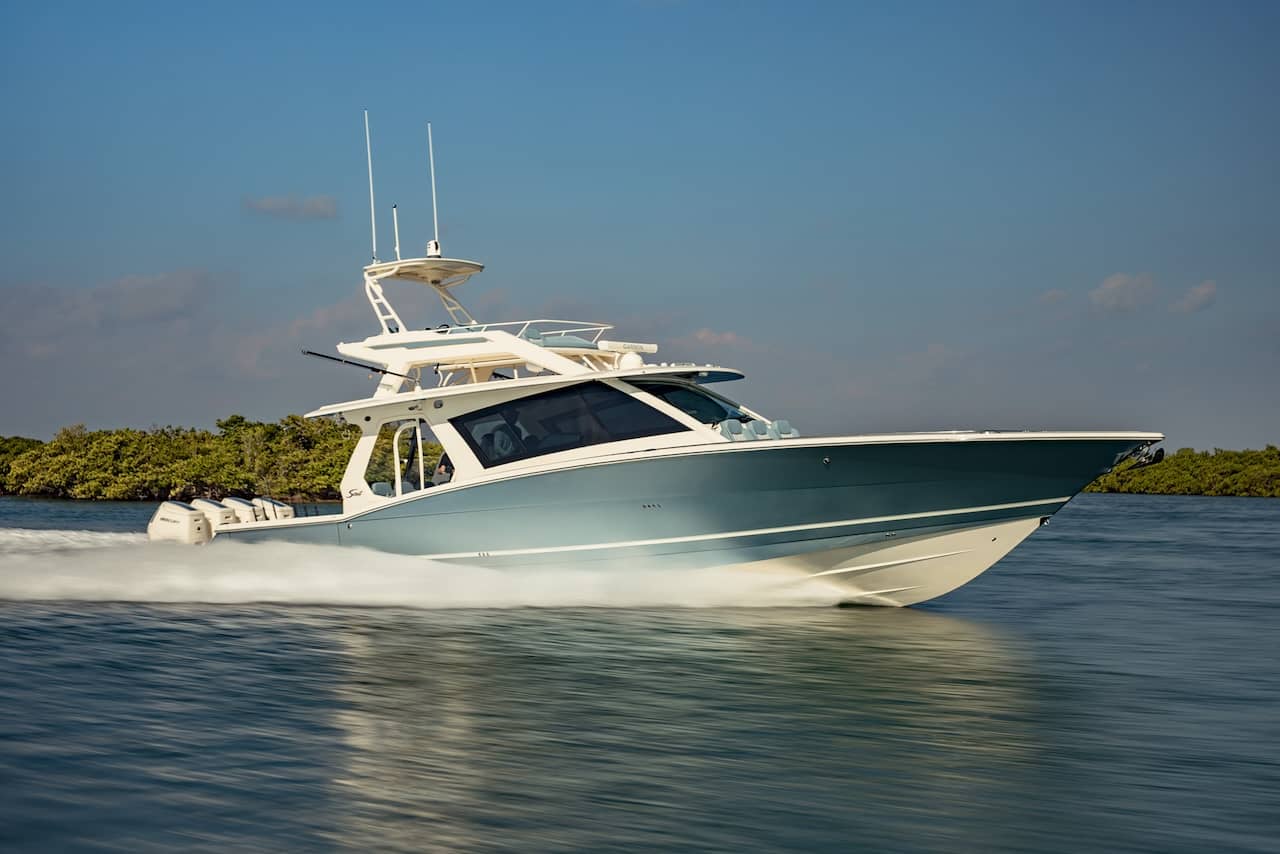
The Scout 530 LXF took the luxury center console to a new level.
Burnham: Scout is a leader in the use of high-tech composites in its larger boats. It gains you hull stiffness and saves weight, but what are the most noticeable benefits for the buyers?
Lang: Performance fuel efficiency, and strength! I can’t tell you how many times I’ve been out on a demo with a customer and listened to them say, “Wow, I had no idea a boat was capable of riding like this. There are several companies that use resin infusion, but the epoxy-infused carbon fiber/E-glass we use is next level! You see it in the aeronautical field and in very high-end luxury cars. It’s the future, and Scout was one of the first to adopt this. Now I’m sure you’ll see more of this as other builders break away from the old way of doing things.
We’ve also been very good at being efficient at our plant. It's very clean. We run off a 5S Lean Six Sigma system. If you look at our factory, everything has a time and a place. On the floor, there's a little taped square that says Plan A QC trash can, and that's where the Plan A QC trash can will be. During the day it might get moved a little bit, but by the end of the day, it's going to be inside of its square.
Every one of our boats, every single part of every boat that we build is built on a laminate schedule. Our engineers are determining what pieces go into fiberglass layup, everything. And then we have CNC routers that cut out those pieces. And as they are cut, the router actually spray paints and labels what it is and where it goes on that piece of glass; they fold it up, put it on a cart, wheel it back lamination, and that team unfolds it and puts it together, like a puzzle, the same exact way every single time. So if we're building 10 of the same model, they're going to be within one or 2% of the same weight versus if you're doing a chop gun they are going to be about 10%.
Burnham: When you launched the 530, it was your biggest model by 10 feet and was much more than a luxury center console. Now you’re moving close to superyacht territory with the 670 LXS you’re about to launch. Who will buy a boat of this size that runs at 60mph? And what kind of learning curve are you on at Scout to satisfy these buyers?
Lang: We have several 530 customers that have already committed to a 670; our tagline for the boat is “Expect Everything” and that’s exactly what you can do. Our buyers for this boat are looking for something that checks ALL the boxes.
I don’t know of another boat out there that can do 60mph-plus, provide as classy and elegantly styled a fishing platform, have the amount of entertainment amenities, sleep up to 8 people, and pull up to a sandbar without damaging props or shafts.
The boat can be also operated and maintained by its owner, and the fishing space is much larger than most sport fishers. I get asked a lot, “Why not just go with a diesel sportfish at that size?” The answer is, you can’t do all the things I just mentioned in a diesel sportfish. I’ve personally fished the 530 with 14 other work colleagues, you can’t do that in a sportfish either—at least you can’t do it and still be friends when you get home!
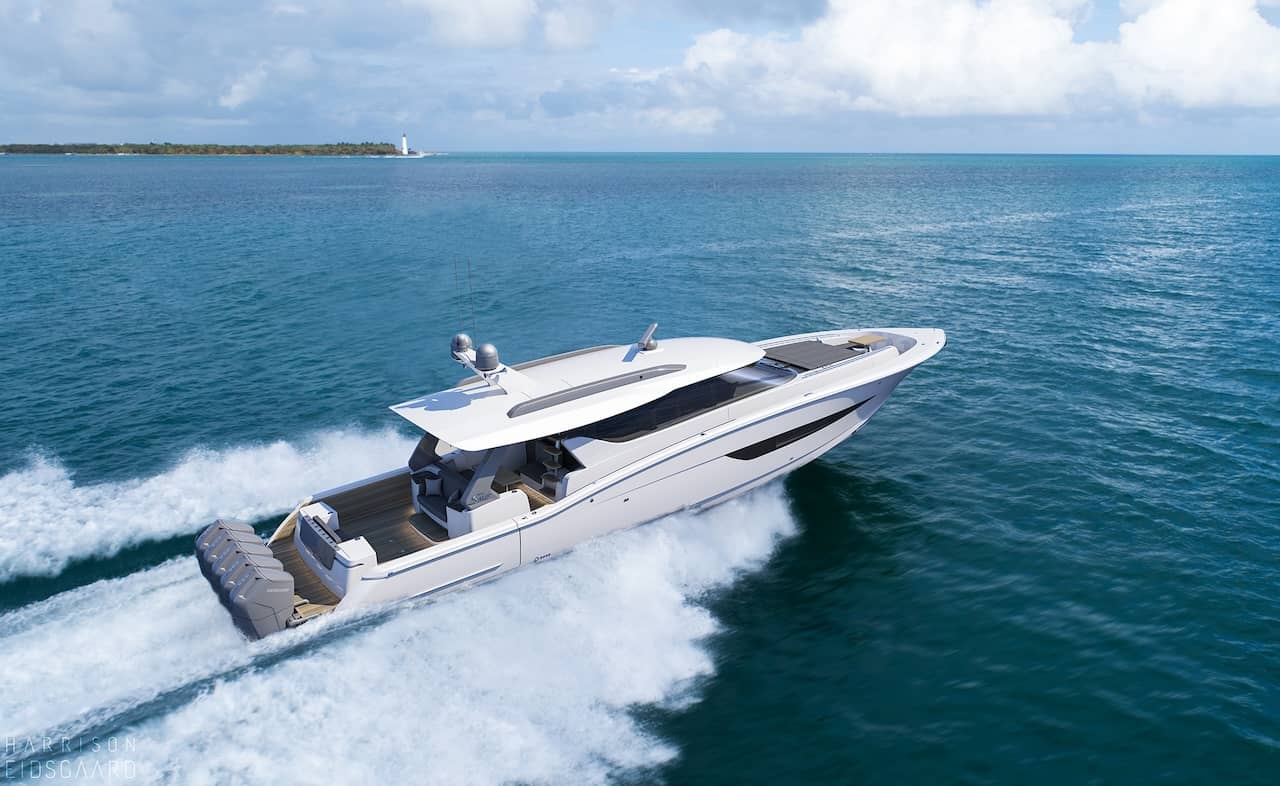
Due to launch in the fall, the Scout 670 LXS aims to take the center-console concept the verge of superyacht territory.
Burnham: It sounds like a new class of luxury fishing boat. Was that your goal to create something that hadn't been built before or sell the biggest center console of all?
Lang: The 670 is something that hasn't been built before. Of course, we study the market and see what's trending and what's selling, but we try to bring new things to market. We've got an innovation timeline on our website of all the things that we pioneered, and a lot of other companies have followed suit. I remember using the dark, football-colored vinyls. Stevie Jr. and I were actually heading to lunch one day, and I said, “Man, I want to do a black bay boat that has vinyl this color”; it was similar to a truck I was driving at the time. He said, “That would be awesome,” and he built a 35-foot center console he did it on and we took it to the Palm Beach show where we had several other manufacturers come by and tell us how crazy we were—that no one would ever buy it. Now if you go look, I think every manufacturer offers a color like that.
So we're first to the market with a lot of stuff like that, taking risks and setting ourselves apart to be unique and try new things. We’ve always focused on high-end automobiles and luxury homes and tried to implement some of those things into the boat to really give you what you're paying for. All boats are expensive, especially the top tier that we’re priced amongst. If you can have features that nobody else has or that emulate what you're used to in an automobile or what you see in your home, I think it adds a ton of value to your investment.
Burnham: So this is not only your biggest boat, but your biggest launch coming up. When does the boat get in the water and what will it cost?
Lang: Now our plan is to have it ready at the 2024 Fort Lauderdale boat show. We haven't gotten full pricing on it yet, but we're looking at somewhere around $5.5 to $6 million.
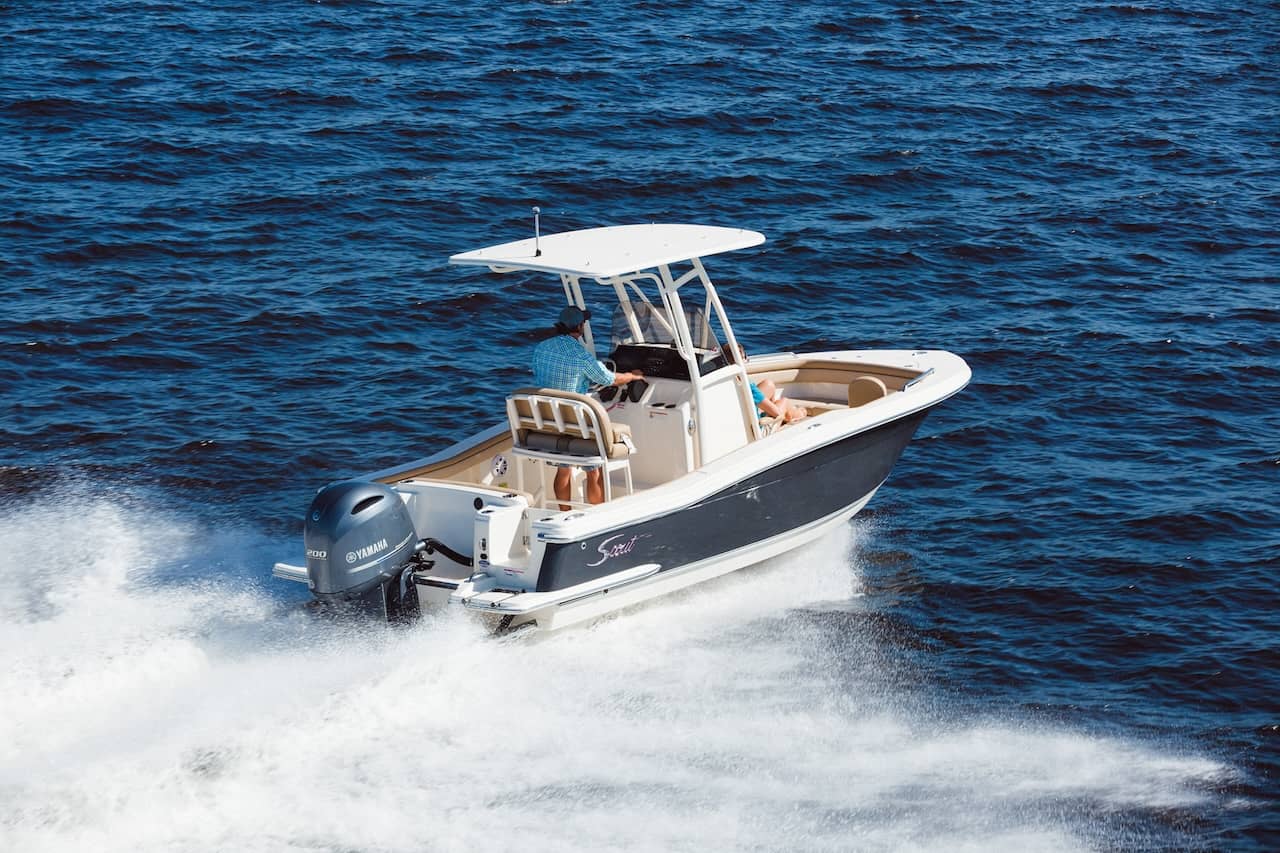
At the heart of the center-console market, Scout’s popular 215 XSF.
Burnham
Everyone can dream about a boat that size, but which Scout model is your bestseller today and why?
Lang: The 215XSF is our best seller; the boat offers so much, from styling to family / fishing functionality. It’s easy to tow, priced right, and it has the best bang for your buck as they say. All Scouts also come with a three-year, limited stem-to-stern warranty along with a 10-year transferable structural hull warranty, which gives customers peace of mind.
Burnham: When you go out on a Scout, what’s your favorite ride?
Lang: What I do most often is cruise with family and friends. I would say I probably fish 20 percent of the time, but it's mostly just to relax. We go out of Charleston, up different rivers to restaurants and all that good stuff—sandbars and beaches—sometimes we'll just pull up a little creek and hang out with family and listen to music and swim.


